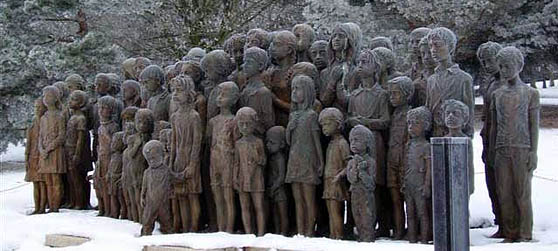
The author of the memorial to child victims in Lidice never saw the final work
 |
"She took on a huge task, as creating so many quality sculptures is something that typically sculptors can't achieve even in their whole lives," Stehlík said to ČTK today.
Uchytilová did not live to see the realization of her work. The first 30 statues were installed in Lidice in 1995, and the last ones were unveiled on June 10, 2000, thirty years after the start of the work and 11 years after the author's death.
"It is sad that sculptor Uchytilová had to face doubts about her work and envy from many colleagues in the field until the end of her life," Stehlík stated, adding that there was even a rumor that she went crazy, having created around three hundred statues of the Lidice children and couldn't stop making them.
According to Stehlík, sculptors and medallists could not forgive her for winning a public competition in the 1950s to design the Czechoslovak one koruna coin. The young woman planting a linden tree adorned the most commonly used domestic currency for nearly 30 years.
This Saturday, the Lidice Memorial premiered the film Living Statues of Dead Children by Tamara Wölfelová, Jana Patková, and Vlaďka Svobodová Potůčková. The fifteen-minute film about the Monument to Child Victims of War, which is the largest monument of its kind in the world, features a personal confession from Uchytilová, who dedicated 40 years of her life to preparing and working on the bronze statue.
Uchytilová (1924 to 1989) modeled each of the 82 murdered children based on preserved photographs with her husband Jiří V. Hampl gradually until her death. After her death, her husband sought funding and cast the individual sculptures in bronze. In the mid-1990s, an unusually large donation came from the Danish town of Albertslund, marking a turning point in the realization.
The Nazis invaded Lidice on June 10, 1942. In a village of 503 inhabitants, 173 men over the age of 15 were shot that day as retaliation for the assassination of Reinhard Heydrich, even though the legal age at that time was 21 years. Women were interned for life in the concentration camp at Ravensbrück, where 53 of them did not survive. Another 26 Lidice residents were executed at the shooting range in Kobylisy.
There were 105 children living in Lidice, of which 88 were probably murdered. Apart from a few selected for Germanization and infants under one year, the Nazis gassed 82 children in the extermination camp in the Polish Chełmno nad Nerrem. One boy died as an infant in a nursery. According to Stehlík, six children were born after the tragedy, four of whom lost their lives under still unexplained circumstances after being forcibly separated from their mothers. Another boy born in October 1942 in Ravensbrück was killed by the Nazis immediately after birth.
After the end of the war, 143 Lidice women and 17 children returned to their homeland. Among them was future Lidice mayor Václav Zelenka, who was four years old at the time of the village's burning. He returned to then Czechoslovakia as the last of the abducted children in May 1947.
The English translation is powered by AI tool. Switch to Czech to view the original text source.
0 comments
add comment










